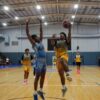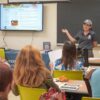HAGÅTÑA (The Guam Daily Post) — Dispelled myths about the vaccine for the coronavirus have spread to the indigenous population of Guam, most of whom have not received their shots to be protected from the disease’s worst symptoms.
“I hear concerns about it changing their DNA, and the word they use to describe this is ‘zombies.’ So, how do you quell that?” said Jesse Alig, mayor of Piti and president of the Mayors’ Council of Guam.
Alig said he’s heard these concerns from CHamoru residents of his home village, regardless of age.
The Department of Public Health and Social Services released data showing just 43% of CHamoru people, the largest ethnic group in Guam, are vaccinated. Local rates for Asian populations, specifically local Korean, Chinese and Filipino residents, are all above 70%, according to the same report. Misinformation about the vaccine may be leading to the low numbers for CHamoru adults, Alig said.
“When we were hosting the first round of testing in the community, I was really impressed with how interested and how concerned our residents were to get tested. So I felt when the vaccines were available to us, perhaps everyone would rush and get vaccinated. But it was different,” Alig told The Guam Daily Post. “I think the response was different toward the vaccine. There was sufficient information for the public to review to make a decision about it, and it’s great we have local physicians that are refuting these stories.”
Alig said he also has heard a common refrain from unvaccinated manamko’, a feeling that they will leave their future up to God.
“I hear it often: ‘Ai adai, boy, esta I’m old already. And whatever the Lord is going to do with me, I’ll accept it.’ And that’s kind of attitude some of our elders have,” he said.
‘Population immunity’
Thousands of local people need to be fully vaccinated in order for the island to reach “population immunity,” a term the government of Guam is using to describe the benchmark of 80% of adults being considered fully vaccinated. Gov. Lou Leon Guerrero said if the goal is reached by July 21, she will lift pandemic restrictions such as reduced crowd capacities for businesses and social gatherings.
As part of expanded efforts to incentivize becoming vaccinated, the governor and the Guam Visitors Bureau put together a weekly raffle drawing for local residents. More than 60,000 residents have entered as of last week’s giveaway of $10,000 and a car.
But Alig said he and other mayors have reached out to families who aren’t vaccinated since the program launched, and even high-value incentives aren’t convincing holdouts.
“We try our best, to call them and offer help if they wanted to get the vaccine — or just to share the schedule of our village clinics. But can you imagine that — even $10,000 or a car aren’t convincing people who are on the fence,” he said.
On Saturday, the governor’s office released a flyer announcing that 2,500 more people need to be vaccinated in order to reach the governor’s goal. Alig agreed that, for an island the size of Guam, closing that gap requires active interest from both the government and the thousands of people officials want to be vaccinated.
“The roads are full. The stores are getting more business. The restaurants are packed. Churches are even more full — I know that for sure,” Alig said. “We want to be healthy so our island can prosper. How can we do that if we don’t get vaccinated? How do we do this if we aren’t all being safe?”

Jesse Alig, center, the mayor of Piti and president of the Mayors’ Council of Guam, said he’s heard CHamoru residents, regardless of age, express concerns that the Covid-19 vaccine will turn them into “zombies.”











